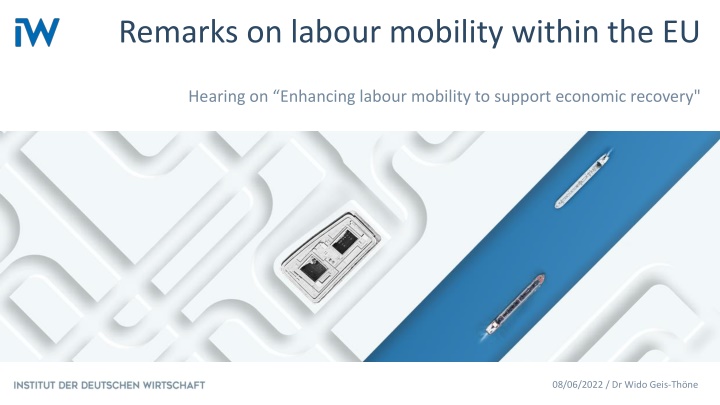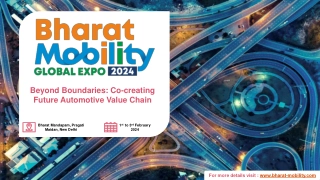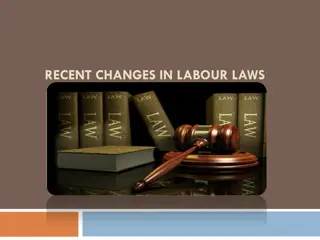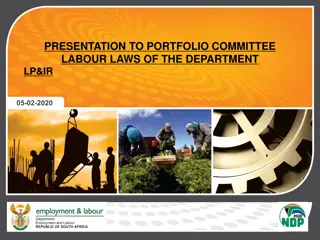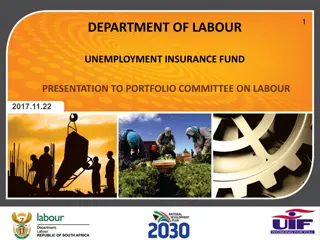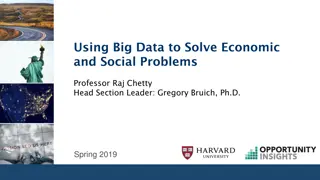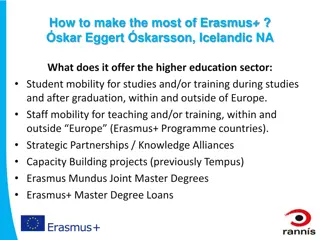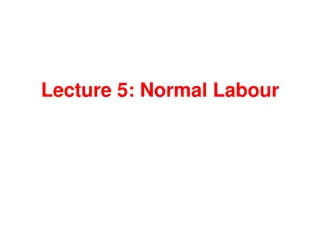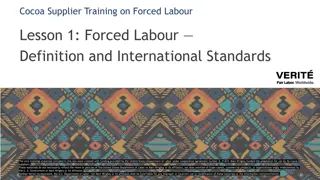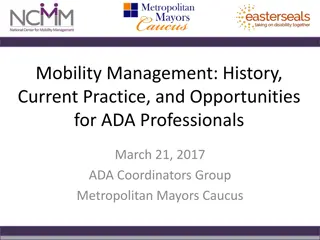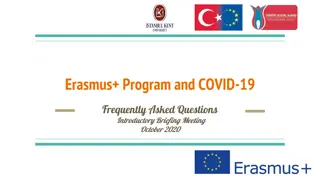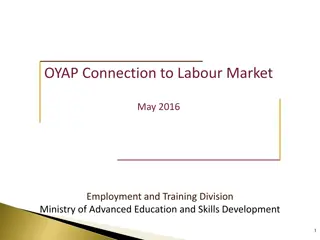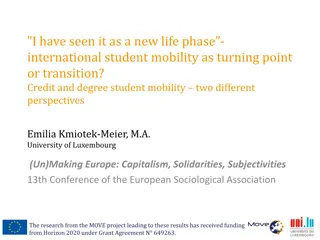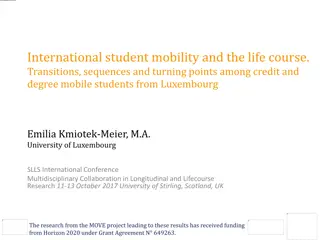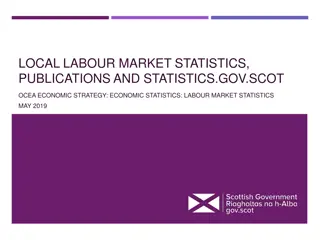Enhancing Labour Mobility within the EU: Insights and Opportunities
This content provides valuable insights on labour mobility within the EU, focusing on migration patterns, obstacles, age structure, regional flows, educational paths, and intentions to emigrate from Germany. Dr. Wido Geis-Thöne shares data and analysis on the dynamics of labour mobility, including reasons for mobility and the impact on economic recovery.
Download Presentation

Please find below an Image/Link to download the presentation.
The content on the website is provided AS IS for your information and personal use only. It may not be sold, licensed, or shared on other websites without obtaining consent from the author.If you encounter any issues during the download, it is possible that the publisher has removed the file from their server.
You are allowed to download the files provided on this website for personal or commercial use, subject to the condition that they are used lawfully. All files are the property of their respective owners.
The content on the website is provided AS IS for your information and personal use only. It may not be sold, licensed, or shared on other websites without obtaining consent from the author.
E N D
Presentation Transcript
Remarks on labour mobility within the EU Hearing on Enhancing labour mobility to support economic recovery" 08/06/2022 / Dr Wido Geis-Th ne
Agenda 1 Migration mouvements in the course of life 2 Obstacles to mobility within the EU 3 Conclusion 08/06/2022 / Dr. Wido Geis-Th ne 2
Age structure of mouvements between EU-countries Values in percent, as of 2020 16.0 15.1 13.3 14.0 12.6 12.0 9.7 10.0 8.1 8.0 6.8 5.4 5.3 5.3 6.0 4.4 3.7 3.5 4.0 2.6 1.9 2.0 1.1 0.6 0.4 0.3 0.0 0-4 5-9 10-14 15-19 20-24 25-29 30-34 35-39 40-44 45-39 50-54 55-59 60-64 65-69 70-74 75-79 80-84 85 years or over Based on numbers on inward migration; excluding countries with missing data Source: Eurostat, 2022; own calculations 08/06/2022 / Dr. Wido Geis-Th ne 3
Regional migration flows in Germany by educational paths Shares of people who migrated in the previous year in 2017 in percent 10.0 8.7 9.0 8.0 7.0 5.7 6.0 5.0 4.3 3.9 4.0 3.2 2.8 2.5 3.0 2.0 1.8 1.5 2.0 1.0 1.0 0.8 1.0 0.0 18 to 24 years 25 to 34 years 35 to 49 years Academic educational path Vocational educational path Low skilled educational path Educational path not determinable All educational pathes Migration between NUTS-2 regions Source: Geis-Th ne, 2022 08/06/2022 / Dr. Wido Geis-Th ne 4
Intentions to emigrate from Germany by education level Values in percent, as of 2019 18 to 24 years Higher level of schooling Medium level of schooling Lower level of schooling 25 to 39 years Academic degree Vocational degree No professional degree 40 to 64 years Academic degree Vocational degree No professional degree 2.2 2.4 13.2 24.6 40.0 7.0 13.1 22.5 22.3 7.2 5.1 10.0 3.4 4.8 13.6 9.3 26.3 5.2 4.8 5.6 14.7 15.5 6.8 3.0 4.2 4.9 5.0 3.6 9.6 12.8 1.7 3.0 7.5 1.9 4.0 13.4 0.0 5.0 10.0 15.0 20.0 25.0 30.0 35.0 40.0 45.0 For ever For some years For some months Higher level of schooling: Hochschulreife; medium level of schooling: Mittlere Reife; lower level of scholling: Hauptschulabschluss oder kein Schulabschluss Source: Geis-Th ne, 2022 08/06/2022 / Dr. Wido Geis-Th ne 5
Reasons for mobility within the EU in the life course Qualification Earnings Others Acquisition of international experience Acquisition of foreign language skills Different study options Acquisition of working experience in different companies or locations Higher wage level and better career prospects Unemployment in the home country Additional income by seasonal work Partnership Migration decision of a family member Culture, environment and climate Migration decisions can have more than one reasons Labour migration can only be due to other reasons than earnings Qualification is particularly relevant for the careers paths of high-skilled workers In most professions, an EU-wide job search is not feasible 08/06/2022 / Dr. Wido Geis-Th ne 6
Agenda 1 Migration mouvements in the course of life 2 Obstacles to mobility within the EU 3 Conclusion 08/06/2022 / Dr. Wido Geis-Th ne 7
Level in the best known foreign language Persons between 25 and 64, values in percent, as of 2016 17.1 7.2 Proficient 11.9 32.7 20.9 9.6 Good 19.0 32.4 29.9 26.1 Basic 35.7 23.6 31.8 56.8 No foreign language known 33.3 11.1 0.0 10.0 20.0 30.0 40.0 50.0 60.0 Total population Low skilled (ISCED levels 0 to 2) Medium skilled (ISCED levels 3 and 4) High skilled (ISCED levels 5 to 8) Source: Eurostat, 2022; own calculations 08/06/2022 / Dr. Wido Geis-Th ne 8
Shares of mothers by age an education level Values in percent, as of 2018 90.0 83.2 75.7 80.0 73.5 72.2 70.0 65.3 60.7 57.2 60.0 52.6 50.0 38.3 40.0 30.0 25.3 25.3 20.0 11.2 10.0 0.0 All women Low skilled Medium skilled High skilled 25 to 29 years 30 to 34 years 35 to 39 years Source: Statistisches Bundesamt 2019; own calculations 08/06/2022 / Dr. Wido Geis-Th ne 9
Further ostacles to mobility within the EU Loss of contact with and support from relatives and friends Sense of home fear of the unknown Difficulties in changing residence due to home ownership and further property Problems with the transferability of educational qualifications Many obstacles are also relevant for mobility within countries 08/06/2022 / Dr. Wido Geis-Th ne 10
Conclusion Mobility within the EU is unique in the world. There are many similarities with internal migration within a country, but also fundamental differences, especially with respect to language skills. There are no good reference points to judge its success. Many motives for migration as well between as within countries are of greater importance for high skilled people. Little mobility of lower-skilled people in the EU must not necessarily be negative. Measures to promote mobility should be oriented towards motives and contexts of migration and remove existing obstacles. A focus should be on the language barriers. 08/06/2022 / Dr. Wido Geis-Th ne 11
